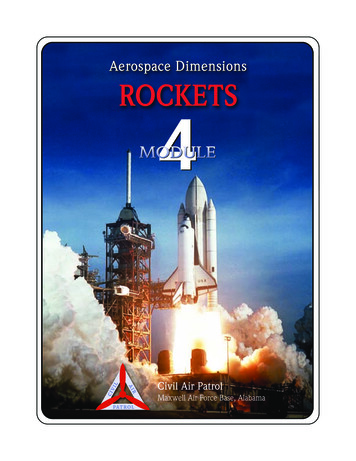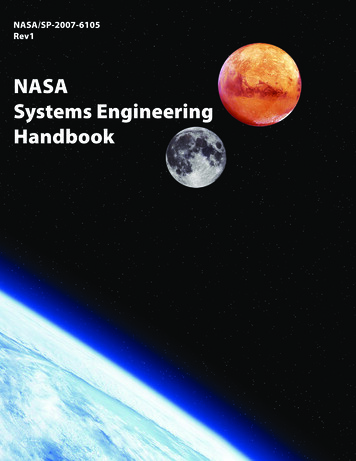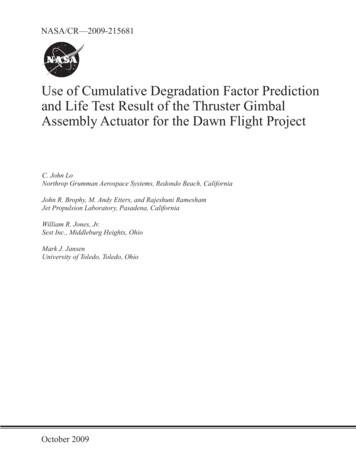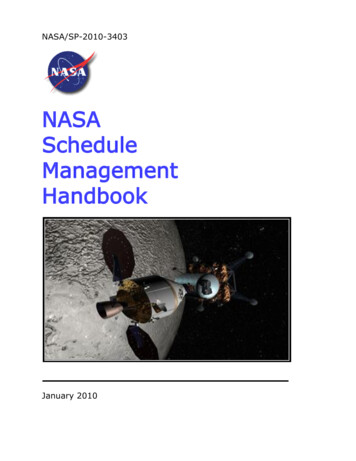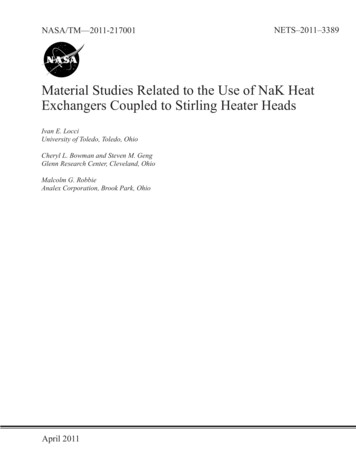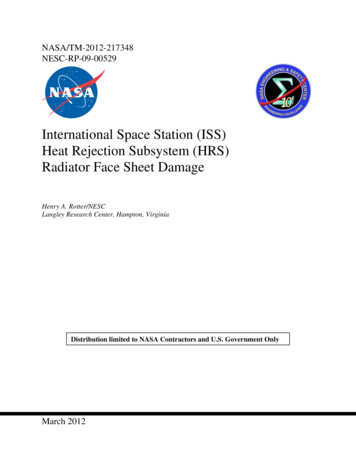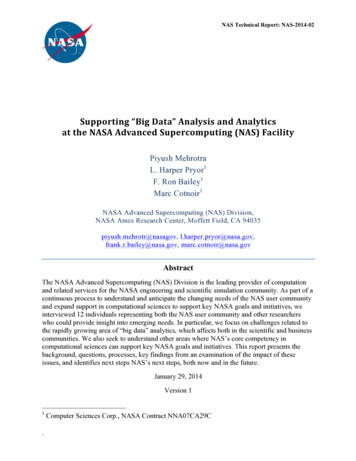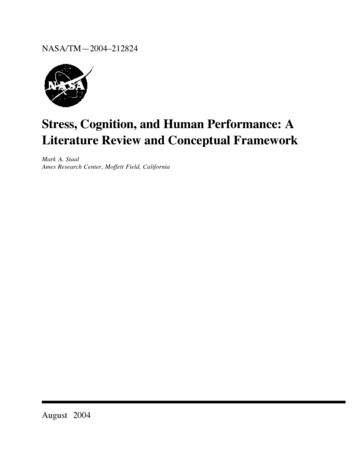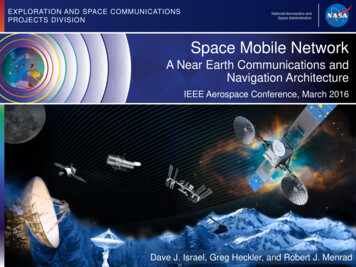
Transcription
RocketsandPeopleVolume IV:The Moon Race
I S B N 978-0-16-089559-39090000780160 895593For sale by the Superintendent of Documents, U.S. Government Printing OfficeInternet: bookstore.gpo.gov Phone: toll free (866) 512-1800; DC area (202) 512-1800Fax: (202) 512-2104 Mail: Stop IDCC, Washington, DC 20402-0001I S B N 978-0-16-089559-3For sale by the SInternet: bookstore.gFax: (202) 5
RocketsandPeopleVolume IV:The Moon RaceBoris ChertokAsif Siddiqi, Series EditorThe NASA History SeriesNational Aeronautics and Space AdministrationOffice of CommunicationsHistory Program OfficeWashington, DCNASA SP-2011-4110
Library of Congress Cataloging-in-Publication DataChertok, B. E. (Boris Evseevich), 1912–[Rakety i lyudi. English]Rockets and People: The Moon Race (Volume IV) / byBoris E. Chertok ;[edited by] Asif A. Siddiqi.p. cm. — (NASA History Series) (NASA SP-2011-4110)Includes bibliographical references and index.1. Chertok, B. E. (Boris Evseevich), 1912– 2. Astronautics—Soviet Union—Biography. 3. Aerospace engineers—Soviet Union—Biography. 4. Astronautics—Soviet Union—History.I. Siddiqi, Asif A., 1966– II. Title. III. Series. IV. SP-2011-4110.TL789.85.C48C4813 2011629.1’092—dc22
I dedicate this bookto the cherished memoryof my wife and friend,Yekaterina Semyonova Golubkina.
Contentsvii
Series IntroductionIn an extraordinary century, Academician Boris Yevseyevich Chertokhas lived an extraordinary life. He has witnessed and participated in manyimportant technological milestones of the 20th century, and in these volumes,he recollects them with clarity, humanity, and humility. Chertok began hiscareer as an electrician in 1930 at an aviation factory near Moscow. Thirtyyears later, he was one of the senior designers in charge of the Soviet Union’scrowning achievement as a space power: the launch of Yuriy Gagarin, theworld’s first space voyager. Chertok’s 60-year-long career, punctuated by theextraordinary accomplishments of both Sputnik and Gagarin, and continuing to the many successes and failures of the Soviet space program, constitutes the core of his memoirs, Rockets and People. In these four volumes,Academician Chertok not only describes and remembers, but also elicitsand extracts profound insights from an epic story about a society’s quest toexplore the cosmos.Academician Chertok’s memoirs, forged from experience in the Cold War,provide a compelling perspective into a past that is indispensable to understanding the present relationship between the American and Russian spaceprograms. From the end of World War II to the present day, the missile andspace efforts of the United States and the Soviet Union (and now Russia) havebeen inextricably linked. As such, although Chertok’s work focuses exclusivelyon Soviet programs to explore space, it also prompts us to reconsider the entirehistory of spaceflight, both Russian and American.Chertok’s narrative underlines how, from the beginning of the ColdWar, the rocketry projects of the two nations evolved in independent butparallel paths. Chertok’s first-hand recollections of the extraordinary Sovietefforts to collect, catalog, and reproduce German rocket technology afterWorld War II provide a parallel view to what historian John Gimbel hascalled the Western “exploitation and plunder” of German technology afterix
Rockets and People: The Moon Racethe war.1 Chertok describes how the Soviet design team under the famousChief Designer Sergey Pavlovich Korolev quickly outgrew German missiletechnology. By the late 1950s, his team produced the majestic R-7, theworld’s first intercontinental ballistic missile. Using this rocket, the SovietUnion launched the first Sputnik satellite on 4 October 1957 from a launchsite in remote central Asia.The early Soviet accomplishments in space exploration, particularly thelaunch of Sputnik in 1957 and the remarkable flight of Yuriy Gagarin in 1961,were benchmarks of the Cold War. Spurred by the Soviet successes, the UnitedStates formed a governmental agency, the National Aeronautics and SpaceAdministration (NASA), to conduct civilian space exploration. As a result ofGagarin’s triumphant flight, in 1961, the Kennedy administration chargedNASA to achieve the goal of “landing a man on the Moon and returning himsafely to the Earth before the end of the decade.”2 Such an achievement woulddemonstrate American supremacy in the arena of spaceflight at a time whenboth American and Soviet politicians believed that victory in space would betantamount to preeminence on the global stage. The space programs of bothcountries grew in leaps and bounds in the 1960s, but the Americans crossedthe finish line first when Apollo astronauts Neil A. Armstrong and EdwinE. “Buzz” Aldrin, Jr., disembarked on the Moon’s surface in July 1969.Shadowing Apollo’s success was an absent question: What happened to theSoviets who had succeeded so brilliantly with Sputnik and Gagarin? Unknownto most, the Soviets tried and failed to reach the Moon in a secret program thatcame to naught. As a result of that disastrous failure, the Soviet Union pursueda gradual and consistent space station program in the 1970s and 1980s thateventually led to the Mir space station. The Americans developed a reusablespace transportation system known as the Space Shuttle. Despite their seeminglyseparate paths, the space programs of the two powers remained dependent oneach other for rationale and direction. When the Soviet Union disintegratedin 1991, cooperation replaced competition as the two countries embarked ona joint program to establish the first permanent human habitation in spacethrough the International Space Station (ISS).Academician Chertok’s reminiscences are particularly important becausehe played key roles in almost every major milestone of the Soviet missile andx
Series Introductionspace programs, from the beginning of World War II to the dissolution of theSoviet Union in 1991. During the war, he served on the team that developedthe Soviet Union’s first rocket-powered airplane, the BI. In the immediate aftermath of the war, Chertok, then in his early 30s, played a key role in studyingand collecting captured German rocket technology. In the latter days of theStalinist era, he worked to develop long-range missiles as deputy chief engineerof the main research institute, the NII-88 (pronounced “nee-88”) near Moscow.In 1956, Korolev’s famous OKB-1 design bureau spun off from the instituteand assumed a leading position in the emerging Soviet space program. As adeputy chief designer at OKB-1, Chertok continued with his contributions tothe most important Soviet space projects of the day: the Vostok; the Voskhod;the Soyuz; the world’s first space station, Salyut; the Energiya superbooster;and the Buran space shuttle.Chertok’s emergence from the secret world of the Soviet military-industrialcomplex, into his current status as the most recognized living legacy of theSoviet space program, coincided with the dismantling of the Soviet Union asa political entity. Throughout most of his career, Chertok’s name remained astate secret. When he occasionally wrote for the public, he used the pseudonym“Boris Yevseyev.”3 Like others writing on the Soviet space program during theCold War, Chertok was not allowed to reveal any institutional or technicaldetails in his writings. What the state censors permitted for publication saidlittle; one could read a book several hundred pages long comprising nothingbeyond tedious and long personal anecdotes between anonymous participantsextolling the virtues of the Communist Party. The formerly immutable limitson free expression in the Soviet Union irrevocably expanded only after MikhailGorbachev’s rise to power in 1985 and the introduction of glasnost’ (openness).Chertok’s name first appeared in print in the newspaper Izvestiya in anarticle commemorating the 30th anniversary of the launch of Sputnik in 1987.In a wide-ranging interview on the creation of Sputnik, Chertok spoke withthe utmost respect for his former boss, the late Korolev. He also eloquentlybalanced love for his country with criticisms of the widespread inertia and inefficiency that characterized late-period Soviet society.4 His first written works inthe glasnost’ period, published in early 1988 in the Air Force journal Aviatsiyai kosmonavtika [Aviation and Cosmonautics], underlined Korolev’s central rolexi
Rockets and People: The Moon Racein the foundation and growth of the Soviet space program.5 By this time, itwas as if all the patched up straps that held together a stagnant empire werefalling apart one by one; even as Russia was in the midst of one of its mosthistoric transformations, the floodgates of free expression were transformingthe country’s own history. People like Chertok were now free to speak abouttheir experiences with candor. Readers could now learn about episodes suchas Korolev’s brutal incarceration in the late 1930s, the dramatic story behindthe fatal space mission of Soyuz-1 in 1967, and details of the failed and abandoned Moon project in the 1960s.6 Chertok himself shed light on a missingpiece of history in a series of five articles published in Izvestiya in early 1992on the German contribution to the foundation of the Soviet missile programafter World War II.7Using these works as a starting point, Academician Chertok began workingon his memoirs. Originally, he had only intended to write about his experiences from the postwar years in one volume, maybe two. Readers responded sopositively to the first volume, Rakety i lyudi [Rockets and People], published in1994, that Chertok continued to write, eventually producing four substantialvolumes, published in 1996, 1997, and 1999, covering the entire history ofthe Soviet missile and space programs.8xii
Series IntroductionMy initial interest in the memoirs was purely historical: I was fascinated bythe wealth of technical arcana in the books, specifically projects and conceptsthat had remained hidden throughout much of the Cold War. Those interestedin dates, statistics, and the “nuts and bolts” of history will find much that isuseful in these pages. As I continued to read, however, I became engrossed bythe overall rhythm of Academician Chertok’s narrative, which gave voice andhumanity to a story ostensibly about mathematics and technology. In his writings, I found a richness that had been nearly absent in most of the disembodied,clinical, and often speculative writing by Westerners studying the Soviet spaceprogram. Because of Chertok’s storytelling skills, his memoir is a much-neededcorrective to the outdated Western view of Soviet space achievements as amishmash of propaganda, self-delusion, and Cold War rhetoric. In Chertok’sstory, we meet real people with real dreams who achieved extraordinary successes under very difficult conditions.Chertok’s reminiscences are remarkably sharp and descriptive. In beingself-reflective, Chertok avoids the kind of solipsistic ruminations that oftencharacterize memoirs. He is both proud of his country’s accomplishments andwilling to admit failings with honesty. For example, Chertok juxtaposes accountsof the famous aviation exploits of Soviet pilots in the 1930s, especially thoseto the Arctic, with the much darker costs of the Great Terror in the late 1930swhen Stalin’s vicious purges decimated the Soviet aviation industry.Chertok’s descriptive powers are particularly evident in describing the chaotic nature of the Soviet mission to recover and collect rocketry equipment inGermany after World War II. Interspersed with his contemporary diary entries,his language conveys the combination of joy, confusion, and often anticlimaxthat the end of the war presaged for Soviet representatives in Germany. In onebreath, Chertok and his team are looking for hidden caches of German matérielin an underground mine, while in another they are face to face with the deadlyconsequences of a soldier who had raped a young German woman (Volume I,Chapter 21).9 There are many such seemingly incongruous anecdotes duringChertok’s time in Germany, from the experience of visiting the Nazi slave laborcamp at Dora soon after liberation in 1945, to the deportation of hundredsof German scientists to the USSR in 1946. Chertok’s massive work is of greatconsequence for another reason—he cogently provides context. Since thebreakup of the Soviet Union in 1991, many participants have openly writtenxiii
Rockets and People: The Moon Raceabout their experiences, but few have successfully placed Soviet space achievements in the broader context of the history of Soviet science, the history ofthe Soviet military-industrial complex, or indeed Soviet history in general.10The volumes of memoirs compiled by the Russian State Archive of ScientificTechnical Documentation in the early 1990s under the series Dorogi v kosmos[Roads to Space] provided an undeniably rich and in-depth view of the originsof the Soviet space program, but they were, for the most part, personal narratives, i.e., fish-eye views of the world around them.11 Chertok’s memoirs are arare exception in that they strive to locate the Soviet missile and space programin the fabric of broader social, political, industrial, and scientific developmentsin the former Soviet Union.This combination—Chertok’s participation in the most important Sovietspace achievements, his capacity to lucidly communicate them to the reader,and his skill in providing a broader social context—makes this work, in myopinion, one of the most important memoirs written by a veteran of the Sovietspace program. The series will also be an important contribution to the historyof Soviet science and technology.12In reading Academician Chertok’s recollections, we should not lose sightof the fact that these chapters, although full of history, have their particularxiv
Series Introductionperspective. In conveying to us the complex vista of the Soviet space program,he has given us one man’s memories of a huge undertaking. Other participantsof these very same events will remember things differently. Soviet space history,like any discipline of history, exists as a continuous process of revision andrestatement. Few historians in the 21st century would claim to be completelyobjective.13 Memoirists would make even less of a claim to the “truth.” In hisintroduction, Chertok acknowledges this, saying, “I must warn the readerthat in no way do I have pretensions to the laurels of a scholarly historian.Correspondingly, my books are not examples of strict historical research. Inany memoirs, narrative and thought are inevitably subjective.” Chertok ablyillustrates, however, that avoiding the pursuit of scholarly history does notnecessarily lessen the relevance of his story, especially because it representsthe opinion of an influential member of the postwar scientific and technicalintelligentsia in the Soviet Union.Some, for example, might not share Chertok’s strong belief in the powerof scientists and engineers to solve social problems, a view that influencedmany who sought to transform the Soviet Union with modern science after theRussian Revolution in 1917. Historians of Soviet science such as Loren Grahamhave argued that narrowly technocratic views of social development cost theSoviet Union dearly.14 Technological hubris was, of course, not unique to theSoviet scientific community, but absent democratic processes of accountability,many huge Soviet government projects—such as the construction of the GreatDnepr Dam and the great Siberian railway in the 1970s and 1980s—ended upas costly failures with many adverse social and environmental repercussions.Whether one agrees or disagrees with Chertok’s views, they are important tounderstand because they represent the ideas of a generation who passionatelybelieved in the power of science to eliminate the ills of society. As such, hismemoirs add an important dimension to understanding the mentalité of theSoviets’ drive to become a modern, industrialized state in the 20th century.Chertok’s memoirs are part of the second generation of publications onSoviet space history, one that eclipsed the (heavily censored) first generationpublished during the Communist era. Memoirs constituted a large part of thesecond generation. In the 1990s, when it was finally possible to write candidlyxv
Rockets and People: The Moon Raceabout Soviet space history, a wave of personal recollections flooded the market.Not only Boris Chertok, but also such luminaries as Vasiliy Mishin, KerimKerimov, Boris Gubanov, Yuriy Mozzhorin, Konstantin Feoktistov, VyacheslavFilin, and others finally published their reminiscences.15 Official organizationalhistories and journalistic accounts complemented these memoirs, written byindividuals with access to secret archival documents. Yaroslav Golovanov’smagisterial Korolev: Fakty i Mify [Korolev: Facts and Myths], as well as key institutional works from the Energiya corporation and the Russian Military SpaceForces, added richly to the canon.16 The diaries of Air Force General NikolayKamanin from the 1960s to the early 1970s, published in four volumes in thelate 1990s, also gave scholars a candid look at the vicissitudes of the Soviethuman spaceflight program.17The flood of works in Russian allowed Westerners to publish the firstworks in English. Memoirs—for example, from Sergey Khrushchev and RoaldSagdeyev—appeared in their English translations. James Harford published his1997 biography of Sergey Korolev based upon extensive interviews with veteransof the Soviet space program.18 My own book, Challenge to Apollo: The Sovietxvi
Series IntroductionUnion and the Space Race, 1945–1974, was an early attempt to synthesize thewealth of information and narrate a complete history of the early Soviet humanspaceflight program.19 Steven Zaloga provided an indispensable counterpoint tothese space histories in The Kremlin’s Nuclear Sword: The Rise and Fall of Russia’sStrategic Nuclear Forces, 1945–2000, which reconstructed the story of the Sovietefforts to develop strategic weapons.20With any new field of history that is bursting with information basedprimarily on recollection and interviews, there are naturally many contradictions and inconsistencies. For example, even on such a seemingly trivial issueas the name of the earliest institute in Soviet-occupied Germany, “InstituteRabe,” there is no firm agreement on the reason it was given this title. Chertok’srecollections contradict the recollection of another Soviet veteran, GeorgiyDyadin.21 In another case, many veterans have claimed that artillery generalLev Gaydukov’s meeting with Stalin in 1945 was a key turning point in theearly Soviet missile program; Stalin apparently entrusted Gaydukov with theresponsibility to choose an industrial sector to assign the development oflong-range rockets (Volume I, Chapter 22). Lists of visitors to Stalin’s officeduring that period—declassified only very recently—do not, however, showthat Gaydukov ever met with Stalin in 1945.22 Similarly, many Russian sourcesnote that the “Second Main Directorate” of the USSR Council of Ministersmanaged Soviet missile development in the early 1950s, when in fact, thisbody actually supervised uranium procurement for the A-bomb project.23 Inmany cases, memoirs provide different and contradictory information on thevery same event (different dates, designations, locations, people involved, etc.).Academician Chertok’s wonderful memoirs point to a solution to thesediscrepancies: a “third generation” of Soviet space history, one that buildsxvii
Rockets and People: The Moon Raceon the rich trove of the first and second generations but is primarily basedon documentary evidence. During the Soviet era, historians could not writehistory based on documents since they could not obtain access to state anddesign bureau archives. As the Soviet Union began to fall apart, historianssuch as Georgiy Vetrov began to take the first steps in document-based history. Vetrov, a former engineer at Korolev’s design bureau, eventually compiledand published two extraordinary collections of primary documents relatingto Korolev’s legacy.24 Now that all the state archives in Moscow—such as theState Archive of the Russian Federation (GARF), the Russian State Archive ofthe Economy (RGAE), and the Archive of the Russian Academy of Sciences(ARAN)—are open to researchers, more results of this “third generation” arebeginning to appear. German historians such as Matthias Uhl and ChristophMick and those in the United States such as myself have been fortunate towork in Russian archives.25 I would also note the enormous contributions ofthe Russian monthly journal Novosti kosmonavtiki [News of Cosmonautics] aswell as the Belgian historian Bart Hendrickx in advancing the state of Sovietspace history. The new work has opened opportunities for future research.For example, we no longer have to guess about the government’s decision toapprove development of the Soyuz spacecraft; we can see the original decreeissued on 4 December 1963.26 Similarly, instead of speculating about thefamous decree of 3 August 1964 that committed the Soviet Union to competing with the American Apollo program, we can study the actual governmentxviii
Series Introductiondocument issued on that date.27 Academician Chertok deserves much creditfor opening the doors for future historians, since his memoirs have guidedmany to look even deeper.The distribution of material spanning the four volumes of Chertok’s memoirs is roughly chronological. In the first English volume, Chertok describeshis childhood, his formative years as an engineer at the aviation Plant No. 22in Fili, his experiences during World War II, and the mission to Germany in1945–46 to study captured German missile technology.In the second volume, he continues the story with his return to the SovietUnion, the reproduction of a Soviet version of the German V-2 and the development of a domestic Soviet rocket industry at the famed NII-88 institutein the Moscow suburb of Podlipki (now called Korolev). He describes thedevelopment of the world’s first intercontinental ballistic missile (ICBM), theR-7; the launch of Sputnik; and the first-generation probes sent to the Moon,Mars, and Venus.In the third volume, he begins with the historic flight of Yuriy Gagarin, thefirst human in space. He discusses several different aspects of the burgeoningSoviet missile and space programs of the early 1960s, including the development of early ICBMs, reconnaissance satellites, the Cuban missile crisis, thefirst Soviet communications satellite Molniya-1, the early spectacular missionsof the Vostok and Voskhod programs, the dramatic Luna program to land aprobe on the Moon, and Sergey Korolev’s last days. He then continues intochapters about the early development of the Soyuz spacecraft, with an in-depthdiscussion of the tragic mission of Vladimir Komarov.The fourth and final volume is largely devoted to the Soviet project to sendcosmonauts to the Moon in the 1960s, covering all aspects of the developmentof the giant N-1 rocket. The last portion of this volume covers the origins ofthe Salyut and Mir space station programs, ending with a fascinating description of the massive Energiya-Buran project, developed as a countermeasure tothe American Space Shuttle.It was my great fortune to meet with Academician Chertok in the summerof 2003. During the meeting, Chertok, a sprightly 91 years old, spoke passionately and emphatically about his life’s work and remained justifiably proudof the achievements of the Russian space program. As I left the meeting, Iwas reminded of something that Chertok had said in one of his first publicxix
Rockets and People: The Moon Raceinterviews in 1987. In describing the contradictions of Sergey Korolev’s personality, Chertok had noted: “This realist, this calculating, [and] farsightedindividual was, in his soul, an incorrigible romantic.”28 Such a description wouldalso be an apt encapsulation of the contradictions of the entire Soviet drive toexplore space, one which was characterized by equal amounts of hardheadedrealism and romantic idealism. Academician Boris Yevseyevich Chertok hascommunicated that idea very capably in his memoirs, and it is my hope thatwe have managed to do justice to his own vision by bringing that story to anEnglish-speaking audience.Asif A. SiddiqiSeries EditorOctober 2004xx
Introduction to Volume IVIn this, the fourth and final volume of his memoirs, Boris Chertokconcludes his monumental trek through a nearly 100-year life. As with theprevious English-language volumes, the text has been significantly modified andextended over the original Russian versions published in the 1990s. The firstvolume covered his childhood, early career, and transformation into a missileengineer by the end of World War II. In the second volume, he took the storyup through the birth of the postwar Soviet ballistic-missile program and thenthe launch of the world’s artificial satellite, Sputnik. This was followed, in thethird volume, by a description of the early and spectacular successes of theSoviet space program in the 1960s, including such unprecedented achievementsas the flight of cosmonaut Yuriy Gagarin. The fourth volume concludes hismemoirs on the history of the Soviet space program with a lengthy meditationon the failed Soviet human lunar program and then brings the story to a closewith the events of the 1970s, 1980s, and 1990s.In the summer of 1989, Soviet censors finally allowed journalists to writeabout an episode of Soviet history that had officially never happened: the massive Soviet effort to compete with Apollo in the 1960s to land a human beingon the Moon. U.S. President John F. Kennedy had laid down the gauntletin a speech in May 1961 to recover some of the self-confidence lost by theseries of Soviet successes in space in the wake of Sputnik. Kennedy’s challengewas embodied in an enormous investment in human spaceflight in the 1960sand culminated in the landing of NASA astronauts Neil A. Armstrong andEdwin E. “Buzz” Aldrin, Jr., on the surface of the Moon in 1969 during theApollo 11 mission.Although a number of Western analysts and observers (not to mentionU.S. intelligence analysts) suspected that the Soviets had been in the race tothe Moon, Soviet spokespersons officially disavowed or rejected the notionthat they had tried to preempt the Americans. This façade eventually crackedat the height of glasnost (“openness”) in the late 1980s. In the summer of1989, Soviet censors permitted the publication of a number of articles andxxi
Rockets and People: The Moon Racebooks that admitted the existence of a human lunar program in the 1960s.1 Asmore and more information emerged in the early 1990s, some salient featuresbegan to emerge: that the program had been massive, that it had involved thedevelopment of a super booster known as the N-1, that all efforts to beat theAmericans had failed, and that evidence of the program had been whitewashedout of existence.2It has become increasingly clear to historians that it would be impossibleto understand the early history of the Soviet space program without accountingfor the motivations and operations of the human lunar landing program. By thelate 1960s, the N1-L3 project constituted about 20 percent of annual budgetexpenditures on Soviet space exploration; by some estimates, total spendingon the Moon program may have been about 4 to 4.5 billion rubles, whichroughly translated to about 12 to 13.5 billion dollars in early 1970s numbers.3But beyond the numbers, the program was undoubtedly one of the mostdramatic episodes in the history of the Soviet space program. During theeventful and troubled period that Chertok covers in this volume, from about1968 to 1974, the Korolev design bureau, now led by the talented but flawedVasiliy Mishin, stumbled from one setback to another. The heart of the program during these years was the giant N-1 rocket, a massive and continuallyevolving technological system whose development was hobbled by difficultcompromises in technical approaches, fighting between leading chief designers, lack of money, and an absence of commitment from the Soviet military,the primary operator of Soviet space infrastructure.Chertok begins his narrative with a discussion of the origins of the N-1 inthe early 1960s and the acrimonious disagreement between Sergey Korolev, thexxii
Introduction to Volume IVchief designer of spacecraft and launch vehicles, and Valentin Glushko, the chiefdesigner of liquid-propellant rocket engines. On one level, theirs was a disagreement over arcane technical issues, particularly over the choice of propellantsfor the N-1, but at a deeper level, the dispute involved fundamental differencesover the future of the Soviet space program. Korolev and Glushko’s differencesover propellants date back to the 1930s when Glushko had embraced storable,hypergolic, and toxic propellants for his innovative engines. By the 1940s,Korolev, meanwhile, had begun to favor cryogenic propellants and believedthat a particular cryogenic combination, liquid hydrogen and liquid oxygen,was the most efficient way forward. Korolev was not alone in this belief. Inthe United States, NASA had invested significant amounts in developing suchengines, but Glushko had an important ally on his side, the military. WhenKorolev and Glushko refused to come to an agreement, a third party, NikolayKuznetsov’s design bureau in the city of Kuybyshev (now Samara), was taskedwith the critical assignment to develop the engines of the N-1.Having known both Korolev and Glushko, Chertok has much to say aboutthe relationship between the two giants of the Soviet space program. Contraryto much innuendo that their relationship was marred by the experience of theGreat Terror in the late 1930s, Chertok shows that they enjoyed a collegial andfriendly rapport well into the 1950s. He reproduces a congratulatory telegram(in C
Chertok’s emergence from the secret world of the Soviet military-industrial complex, into his current status as the most recognized living legacy of the Soviet space program, coincided with the dismantling of the Soviet Union as a political entity. Throughout most of his career,

